latch INFINITI Q50 2014 User Guide
[x] Cancel search | Manufacturer: INFINITI, Model Year: 2014, Model line: Q50, Model: INFINITI Q50 2014Pages: 394, PDF Size: 1.99 MB
Page 44 of 394
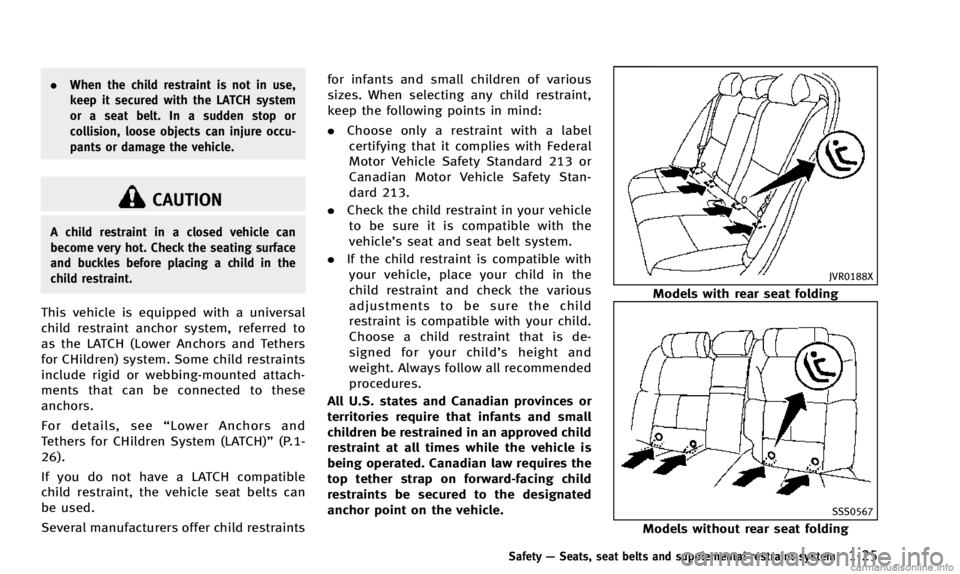
.When the child restraint is not in use,
keep it secured with the LATCH system
or a seat belt. In a sudden stop or
collision, loose objects can injure occu-
pants or damage the vehicle.
CAUTION
A child restraint in a closed vehicle can
become very hot. Check the seating surface
and buckles before placing a child in the
child restraint.
This vehicle is equipped with a universal
child restraint anchor system, referred to
as the LATCH (Lower Anchors and Tethers
for CHildren) system. Some child restraints
include rigid or webbing-mounted attach-
ments that can be connected to these
anchors.
For details, see “Lower Anchors and
Tethers for CHildren System (LATCH)” (P.1-
26).
If you do not have a LATCH compatible
child restraint, the vehicle seat belts can
be used.
Several manufacturers offer child restraints for infants and small children of various
sizes. When selecting any child restraint,
keep the following points in mind:
.
Choose only a restraint with a label
certifying that it complies with Federal
Motor Vehicle Safety Standard 213 or
Canadian Motor Vehicle Safety Stan-
dard 213.
. Check the child restraint in your vehicle
to be sure it is compatible with the
vehicle’s seat and seat belt system.
. If the child restraint is compatible with
your vehicle, place your child in the
child restraint and check the various
adjustments to be sure the child
restraint is compatible with your child.
Choose a child restraint that is de-
signed for your child’ s height and
weight. Always follow all recommended
procedures.
All U.S. states and Canadian provinces or
territories require that infants and small
children be restrained in an approved child
restraint at all times while the vehicle is
being operated. Canadian law requires the
top tether strap on forward-facing child
restraints be secured to the designated
anchor point on the vehicle.
JVR0188X
Models with rear seat folding
SSS0567
Models without rear seat folding
Safety —Seats, seat belts and supplemental restraint system1-25
Page 45 of 394
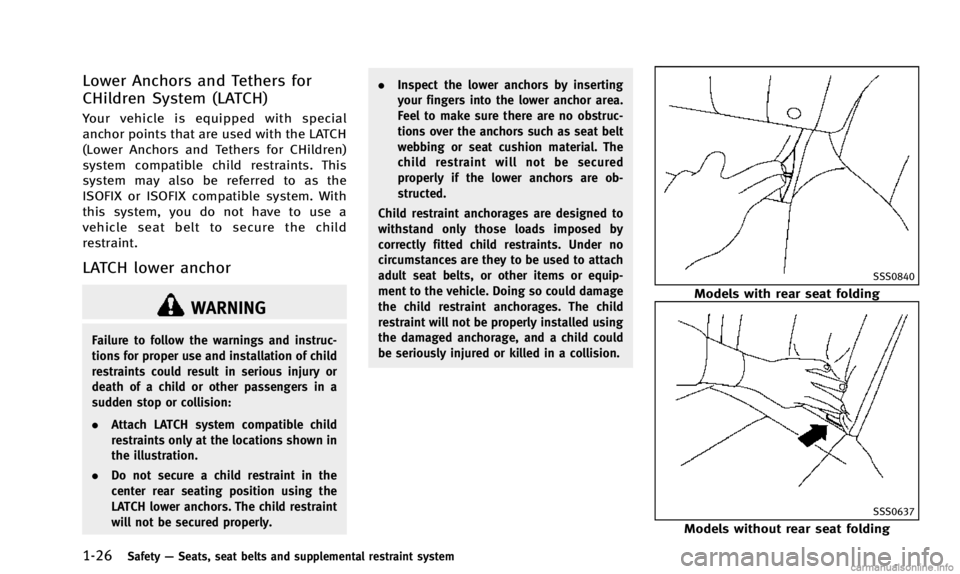
1-26Safety—Seats, seat belts and supplemental restraint system
Lower Anchors and Tethers for
CHildren System (LATCH)
Your vehicle is equipped with special
anchor points that are used with the LATCH
(Lower Anchors and Tethers for CHildren)
system compatible child restraints. This
system may also be referred to as the
ISOFIX or ISOFIX compatible system. With
this system, you do not have to use a
vehicle seat belt to secure the child
restraint.
LATCH lower anchor
WARNING
Failure to follow the warnings and instruc-
tions for proper use and installation of child
restraints could result in serious injury or
death of a child or other passengers in a
sudden stop or collision:
. Attach LATCH system compatible child
restraints only at the locations shown in
the illustration.
. Do not secure a child restraint in the
center rear seating position using the
LATCH lower anchors. The child restraint
will not be secured properly. .
Inspect the lower anchors by inserting
your fingers into the lower anchor area.
Feel to make sure there are no obstruc-
tions over the anchors such as seat belt
webbing or seat cushion material. The
child restraint will not be secured
properly if the lower anchors are ob-
structed.
Child restraint anchorages are designed to
withstand only those loads imposed by
correctly fitted child restraints. Under no
circumstances are they to be used to attach
adult seat belts, or other items or equip-
ment to the vehicle. Doing so could damage
the child restraint anchorages. The child
restraint will not be properly installed using
the damaged anchorage, and a child could
be seriously injured or killed in a collision.
SSS0840
Models with rear seat folding
SSS0637
Models without rear seat folding
Page 46 of 394
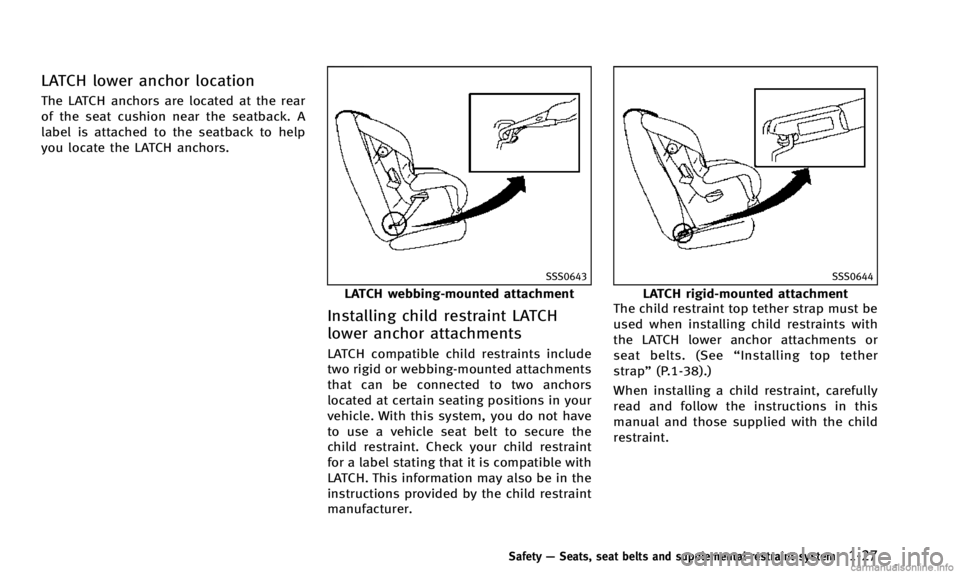
LATCH lower anchor location
The LATCH anchors are located at the rear
of the seat cushion near the seatback. A
label is attached to the seatback to help
you locate the LATCH anchors.
SSS0643
LATCH webbing-mounted attachment
Installing child restraint LATCH
lower anchor attachments
LATCH compatible child restraints include
two rigid or webbing-mounted attachments
that can be connected to two anchors
located at certain seating positions in your
vehicle. With this system, you do not have
to use a vehicle seat belt to secure the
child restraint. Check your child restraint
for a label stating that it is compatible with
LATCH. This information may also be in the
instructions provided by the child restraint
manufacturer.
SSS0644
LATCH rigid-mounted attachment
The child restraint top tether strap must be
used when installing child restraints with
the LATCH lower anchor attachments or
seat belts. (See “Installing top tether
strap” (P.1-38).)
When installing a child restraint, carefully
read and follow the instructions in this
manual and those supplied with the child
restraint.
Safety —Seats, seat belts and supplemental restraint system1-27
Page 47 of 394
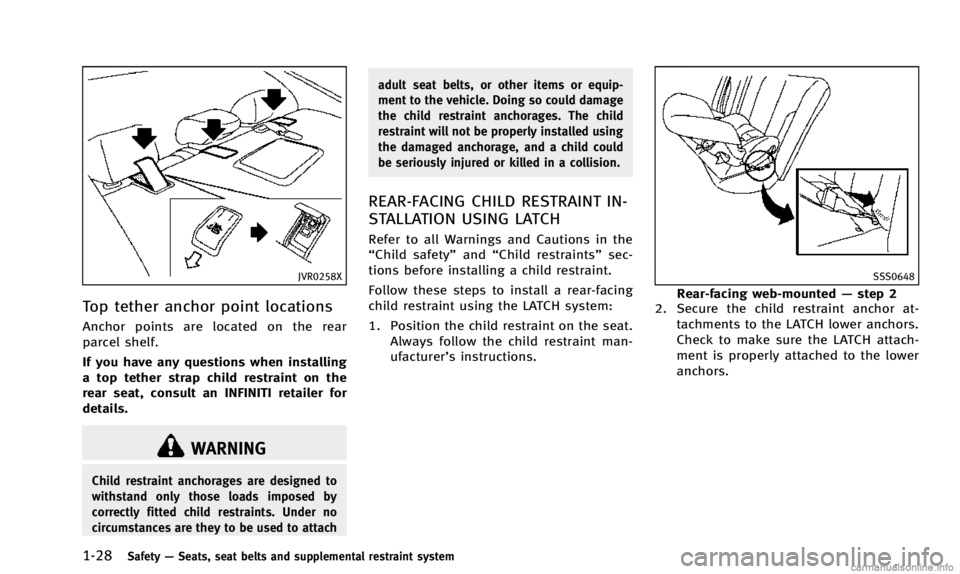
1-28Safety—Seats, seat belts and supplemental restraint system
JVR0258X
Top tether anchor point locations
Anchor points are located on the rear
parcel shelf.
If you have any questions when installing
a top tether strap child restraint on the
rear seat, consult an INFINITI retailer for
details.
WARNING
Child restraint anchorages are designed to
withstand only those loads imposed by
correctly fitted child restraints. Under no
circumstances are they to be used to attach adult seat belts, or other items or equip-
ment to the vehicle. Doing so could damage
the child restraint anchorages. The child
restraint will not be properly installed using
the damaged anchorage, and a child could
be seriously injured or killed in a collision.
REAR-FACING CHILD RESTRAINT IN-
STALLATION USING LATCH
Refer to all Warnings and Cautions in the
“Child safety”
and“Child restraints” sec-
tions before installing a child restraint.
Follow these steps to install a rear-facing
child restraint using the LATCH system:
1. Position the child restraint on the seat. Always follow the child restraint man-
ufacturer’s instructions.
SSS0648
Rear-facing web-mounted —step 2
2. Secure the child restraint anchor at-
tachments to the LATCH lower anchors.
Check to make sure the LATCH attach-
ment is properly attached to the lower
anchors.
Page 48 of 394
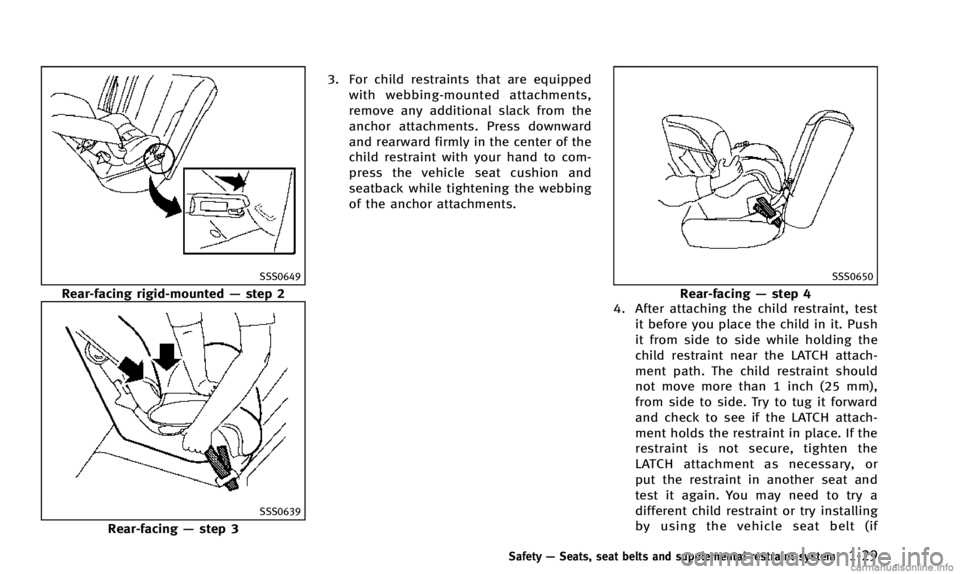
SSS0649
Rear-facing rigid-mounted—step 2
SSS0639
Rear-facing —step 3 3. For child restraints that are equipped
with webbing-mounted attachments,
remove any additional slack from the
anchor attachments. Press downward
and rearward firmly in the center of the
child restraint with your hand to com-
press the vehicle seat cushion and
seatback while tightening the webbing
of the anchor attachments.
SSS0650
Rear-facing —step 4
4. After attaching the child restraint, test
it before you place the child in it. Push
it from side to side while holding the
child restraint near the LATCH attach-
ment path. The child restraint should
not move more than 1 inch (25 mm),
from side to side. Try to tug it forward
and check to see if the LATCH attach-
ment holds the restraint in place. If the
restraint is not secure, tighten the
LATCH attachment as necessary, or
put the restraint in another seat and
test it again. You may need to try a
different child restraint or try installing
by using the vehicle seat belt (if
Safety —Seats, seat belts and supplemental restraint system1-29
Page 50 of 394
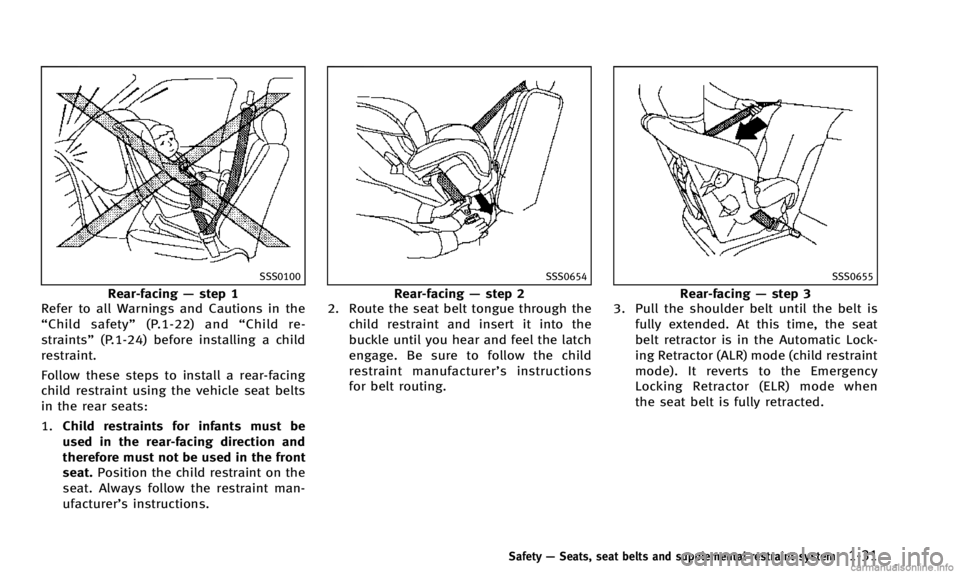
SSS0100
Rear-facing—step 1
Refer to all Warnings and Cautions in the
“ Child safety” (P.1-22) and“Child re-
straints” (P.1-24) before installing a child
restraint.
Follow these steps to install a rear-facing
child restraint using the vehicle seat belts
in the rear seats:
1. Child restraints for infants must be
used in the rear-facing direction and
therefore must not be used in the front
seat. Position the child restraint on the
seat. Always follow the restraint man-
ufacturer’s instructions.
SSS0654
Rear-facing —step 2
2. Route the seat belt tongue through the
child restraint and insert it into the
buckle until you hear and feel the latch
engage. Be sure to follow the child
restraint manufacturer’ s instructions
for belt routing.
SSS0655
Rear-facing —step 3
3. Pull the shoulder belt until the belt is
fully extended. At this time, the seat
belt retractor is in the Automatic Lock-
ing Retractor (ALR) mode (child restraint
mode). It reverts to the Emergency
Locking Retractor (ELR) mode when
the seat belt is fully retracted.
Safety —Seats, seat belts and supplemental restraint system1-31
Page 52 of 394
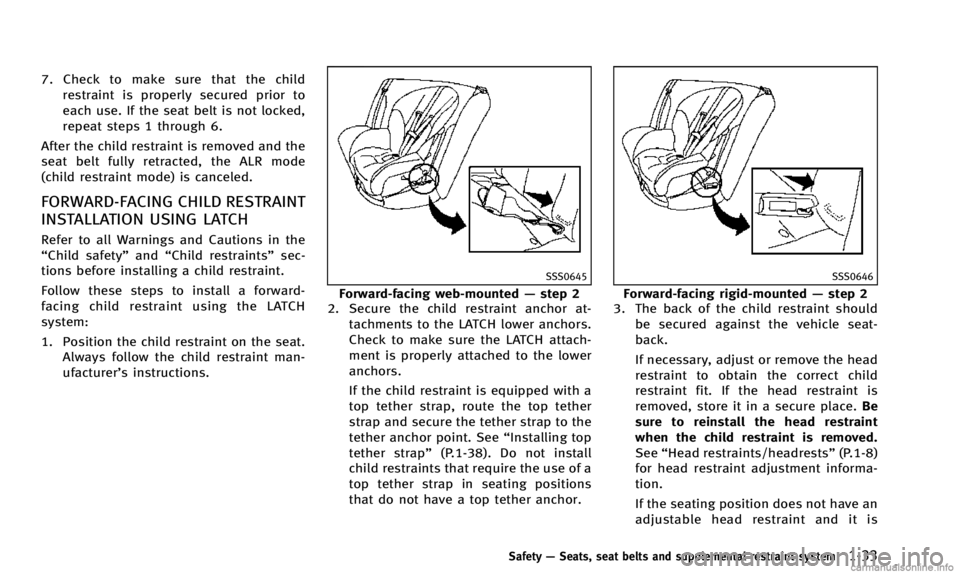
7. Check to make sure that the childrestraint is properly secured prior to
each use. If the seat belt is not locked,
repeat steps 1 through 6.
After the child restraint is removed and the
seat belt fully retracted, the ALR mode
(child restraint mode) is canceled.
FORWARD-FACING CHILD RESTRAINT
INSTALLATION USING LATCH
Refer to all Warnings and Cautions in the
“Child safety” and“Child restraints” sec-
tions before installing a child restraint.
Follow these steps to install a forward-
facing child restraint using the LATCH
system:
1. Position the child restraint on the seat. Always follow the child restraint man-
ufacturer’s instructions.
SSS0645
Forward-facing web-mounted —step 2
2. Secure the child restraint anchor at-
tachments to the LATCH lower anchors.
Check to make sure the LATCH attach-
ment is properly attached to the lower
anchors.
If the child restraint is equipped with a
top tether strap, route the top tether
strap and secure the tether strap to the
tether anchor point. See “Installing top
tether strap” (P.1-38). Do not install
child restraints that require the use of a
top tether strap in seating positions
that do not have a top tether anchor.
SSS0646
Forward-facing rigid-mounted —step 2
3. The back of the child restraint should
be secured against the vehicle seat-
back.
If necessary, adjust or remove the head
restraint to obtain the correct child
restraint fit. If the head restraint is
removed, store it in a secure place. Be
sure to reinstall the head restraint
when the child restraint is removed.
See “Head restraints/headrests” (P.1-8)
for head restraint adjustment informa-
tion.
If the seating position does not have an
adjustable head restraint and it is
Safety —Seats, seat belts and supplemental restraint system1-33
Page 53 of 394

1-34Safety—Seats, seat belts and supplemental restraint system
interfering with the proper child re-
straint fit, try another seating position
or a different child restraint.
SSS0647
Forward-facing —step 4
4. For child restraints that are equipped
with webbing-mounted attachments,
remove any additional slack from the
anchor attachments. Press downward
and rearward firmly in the center of the
child restraint with your knee to com-
press the vehicle seat cushion and
seatback while tightening the webbing
of the anchor attachments.
5. Tighten the tether strap according to the manufacturer’s instructions to re-
move any slack.
SSS0638
Forward-facing —step 6
6. After attaching the child restraint, test
it before you place the child in it. Push
it from side to side while holding the
child restraint near the LATCH attach-
ment path. The child restraint should
not move more than 1 inch (25 mm),
from side to side. Try to tug it forward
and check to see if the LATCH attach-
ment holds the restraint in place. If the
restraint is not secure, tighten the
LATCH attachment as necessary, or
put the restraint in another seat and
test it again. You may need to try a
different child restraint. Not all child
restraints fit in all types of vehicles.
Page 55 of 394
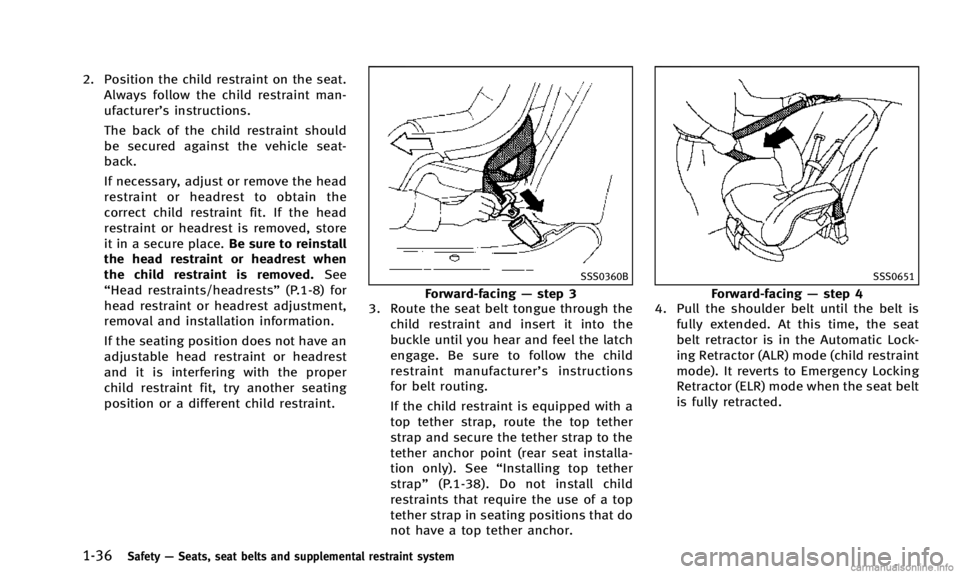
1-36Safety—Seats, seat belts and supplemental restraint system
2. Position the child restraint on the seat.
Always follow the child restraint man-
ufacturer’s instructions.
The back of the child restraint should
be secured against the vehicle seat-
back.
If necessary, adjust or remove the head
restraint or headrest to obtain the
correct child restraint fit. If the head
restraint or headrest is removed, store
it in a secure place. Be sure to reinstall
the head restraint or headrest when
the child restraint is removed. See
“Head restraints/headrests” (P.1-8) for
head restraint or headrest adjustment,
removal and installation information.
If the seating position does not have an
adjustable head restraint or headrest
and it is interfering with the proper
child restraint fit, try another seating
position or a different child restraint.
SSS0360B
Forward-facing —step 3
3. Route the seat belt tongue through the
child restraint and insert it into the
buckle until you hear and feel the latch
engage. Be sure to follow the child
restraint manufacturer’ s instructions
for belt routing.
If the child restraint is equipped with a
top tether strap, route the top tether
strap and secure the tether strap to the
tether anchor point (rear seat installa-
tion only). See “Installing top tether
strap” (P.1-38). Do not install child
restraints that require the use of a top
tether strap in seating positions that do
not have a top tether anchor.
SSS0651
Forward-facing —step 4
4. Pull the shoulder belt until the belt is
fully extended. At this time, the seat
belt retractor is in the Automatic Lock-
ing Retractor (ALR) mode (child restraint
mode). It reverts to Emergency Locking
Retractor (ELR) mode when the seat belt
is fully retracted.
Page 58 of 394
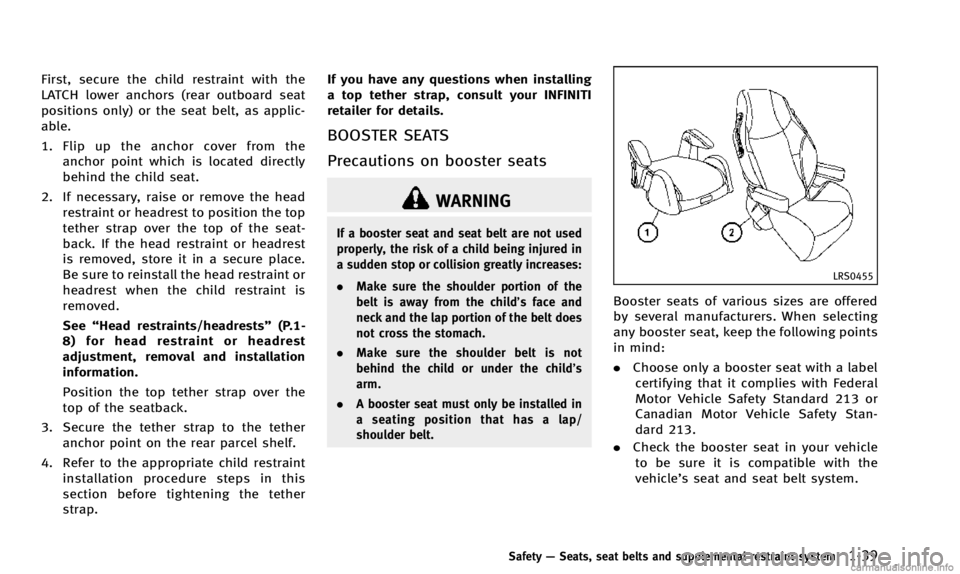
First, secure the child restraint with the
LATCH lower anchors (rear outboard seat
positions only) or the seat belt, as applic-
able.
1. Flip up the anchor cover from theanchor point which is located directly
behind the child seat.
2. If necessary, raise or remove the head restraint or headrest to position the top
tether strap over the top of the seat-
back. If the head restraint or headrest
is removed, store it in a secure place.
Be sure to reinstall the head restraint or
headrest when the child restraint is
removed.
See “Head restraints/headrests” (P.1-
8) for head restraint or headrest
adjustment, removal and installation
information.
Position the top tether strap over the
top of the seatback.
3. Secure the tether strap to the tether anchor point on the rear parcel shelf.
4. Refer to the appropriate child restraint installation procedure steps in this
section before tightening the tether
strap. If you have any questions when installing
a top tether strap, consult your INFINITI
retailer for details.
BOOSTER SEATS
Precautions on booster seats
WARNING
If a booster seat and seat belt are not used
properly, the risk of a child being injured in
a sudden stop or collision greatly increases:
.
Make sure the shoulder portion of the
belt is away from the child’s face and
neck and the lap portion of the belt does
not cross the stomach.
. Make sure the shoulder belt is not
behind the child or under the child’s
arm.
. A booster seat must only be installed in
a seating position that has a lap/
shoulder belt.
LRS0455
Booster seats of various sizes are offered
by several manufacturers. When selecting
any booster seat, keep the following points
in mind:
.Choose only a booster seat with a label
certifying that it complies with Federal
Motor Vehicle Safety Standard 213 or
Canadian Motor Vehicle Safety Stan-
dard 213.
. Check the booster seat in your vehicle
to be sure it is compatible with the
vehicle’s seat and seat belt system.
Safety —Seats, seat belts and supplemental restraint system1-39